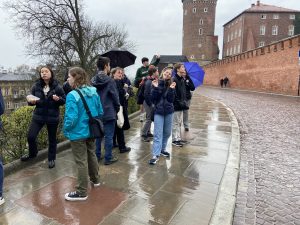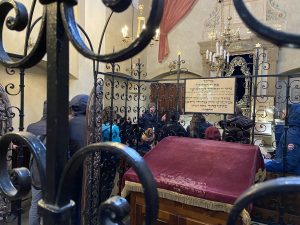Lauren L. ’24, Eric ’24, and Ben ’24, recount impactful visits to Ghetto Heroes Square, the Galicia Jewish Museum, and Krakow’s Old Town.
A memorial that caught my eye today was the empty chairs in Ghetto Heroes Square that came about in 2005. There are 70 empty chairs sitting isolated from each other, the looming gap in between them emphasizes the irreplaceable void left behind by absent Jews. The location alone holds significance as the square was the ghetto’s Umschlagplatz where Jews were assembled to be brought to their deaths.
In March of 1941, Jews were under the false impression that they were simply reallocating. Little did they know that they were being sent to concentration camps where personal items and furniture would not be allowed. The Jews had no choice but to abandon their belongings at the square after the ghetto liquidated in March, 1943. Following the liquidation, only empty chairs were left.
I admire how the memorial leverages emotional and physical means that forces by-passers to slow down in their tracks to confront a tragic history. Emotionally, the chairs’ sparse dispersion creates an overwhelming sense of emptiness that effectively pulls at one’s pathos. While, physically, the arrangement of chairs forces people to navigate around, rather than beelining through the streets. Throughout this trip, Mr. Leistler has been saying, “You have to go there to know there.” In this instance, the memorial exemplifies his words. Knowing the number of deaths, though large, serves as a distant statistic. However, engaging with the memorial makes one better comprehend the weight of their deaths and the absence those fatalities brought.
-Lauren L. ’24
The Galicia Jewish Museum was built inside a tram station. It had a single spacious exhibit of photographs along with captions beneath. However, it was this simple setup that revealed to me some of the most gruesome and heart-wrenching truths of the Holocaust in Poland. The captions were elegantly written and depicted tapestries of Jewish culture and mistreatment throughout history. Cruel betrayers and Nazi collaborators alongside Polish sympathizers and rescuers, the exhibit explored the breadth and depth of human nature. Yet perhaps the most striking was its gruesome details about Auschwitz and the absolute inhumane horror of it, adding to the suspense tomorrow. What surprised me the most however, was its exhibit on Polish cruelty and antisemitism after the war. I was horrified and outraged to learn that even after the war in 1946 (!!), a few Poles had kidnapped, tortured and brutally murdered five Jews, one of whom was an Auschwitz survivor, all because of antisemitism! It tore my heart out for the poor man who survived Auschwitz just to be buried again by the hatred of men who were just in solidarity a year before.
On my way out of the exhibit, I passed by its miniature bookstore. I picked up a copy of Hannah Arendt’s “Eichmann in Jerusalem.” It was Arendt’s defining account of Adolf Eichmann’s trial in 1962 and where she first proposed “The Banality of Evil.” She argues that evil comes from “simply following orders,” not questioning the morality of what you are doing and merely doing because you are told. Put simply, when you follow orders, you become a gear. With enough connected gears, even the slightest evil turn can cause a catastrophic chain reaction and perhaps it was that unwitting, “banal,” collaboration of normal people all around Europe, fueled by the genocidal delusions of a few men that ultimately created the horror of the Holocaust, or so according to Arendt. I would have to read more to find out!
-Eric ’24
On Noticing
We have all been warned about the dangers of interacting with uneasily friendly strangers. Today, I got to utilize those lessons in full force.
First, as we strolled through the Krakow Old Town on our way to lunch, I noticed a fairly well-dressed gentleman walking in the opposite direction, and made eye contact with him. This was my fatal mistake. As soon as he noticed that I noticed him, he demonstrated that he had noticed me by mirroring every single one of my movements. As we approached each other, he shifted the clipboard in his arm and stuck out his hand as if to shake mine, simultaneously putting on a friendly smile and exclaiming “Hi, Hello!” I, following the instincts ingrained in me, skirted around him, determinedly looking forward.
After lunch, as I wandered through the city by myself, a similar situation occurred no less than four times, each time with a different person holding a clipboard, and each time I would swerve out of the way. It got to the point where when I would see any person with a clipboard who looked ready to pounce on unsuspecting pedestrians, I would run to the other side of the street. I began to wonder what it was about me that caused them to notice me, and why it made me so uncomfortable. I settled on the fact that they must have targeted me because they noticed I was a tourist, and focused on looking as confidently local as possible. In my preoccupation with trying so hard not to be noticed, I completely forgot to notice the places I was passing through and the buildings surrounding me, though my goal had been to wander through Krakow exploring the architecture and scenery. My obsession with being inconspicuous limited my ability to see the world around me. Eventually, when I strolled into the park circling the Old Town, I reorganized myself, and got to get a real look around. Now, when I walked down the very same streets that I had just gone down, I noticed buildings I had never seen before, and restaurants that hadn’t caught my eye. What I realized, as I rediscovered Krakow, was that the significance of our trip lay not in learning what was previously unknown to us individually, but in returning to our past knowledge in order to discover new things, and hopefully, along the way, getting to notice a little bit more of the world around us.
-Ben ’24





